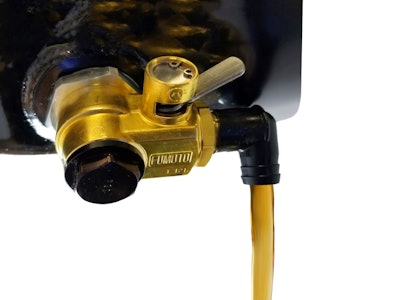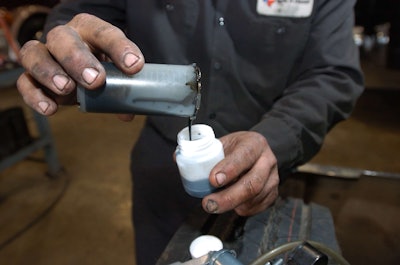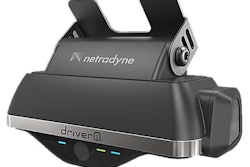
“I think it’s a very good way to be proactive on maintenance,” said Stede Granger, OEM technical services manager for Shell Lubricants, who has studied thousands of engine oil reviews over the past 40 years.
Granger said mechanical systems typically provide a warning of some type.
“If you’re smart enough to pay attention to that warning, you can do things like work to prevent breakdowns on the road, because you get a warning ahead of time before the catastrophic failure happens or the failure happens to the point that you can’t drive the truck,” he said. “This is a way for you to pick up on early warnings before the failure actually happens.”
Dave Latimer, vice president of shop operations for Pilot Flying J Truck Care, said that in addition to taking a closer look at engine health, an oil sampling program can lead to longer drain intervals, which reduces costs and frees up technicians to take on other projects.
“By having a good oil analysis program, you can maximize your serviceability,” Latimer said. “You can extend your drain, taking it out as far as what’s best for your vehicle without causing any damage. I always look at it and say it’s really very cheap insurance. It’s not an expensive endeavor, but it amazes me that more companies do not participate.”
The American Petroleum Institute, which regularly tests oils to ensure that they live up to the manufacturer’s performance claims, believes oil sampling among fleets makes good sense.
“There’s a false way of thinking that all oils are the same,” said Kevin Ferrick, director for API Product Programs. “We’ve licensed more than 20,000 products in our system, so that tells me that there’s more than one way to make an engine oil. If fleets are devoting some time to making sure that the oil is performing as they expect, I think that’s a wise thing for them to do.”
One company that does participate in regular oil testing is Dot Transportation Inc., a wholly owned subsidiary of Dot Foods, Inc., the nation’s largest food industry redistributor.
Dot relies on ExxonMobil to take a closer look at engine performance through careful examination of their used engine oil. Reports are shared with Dot.
“The big benefit is seeing the results come back with no alerts,” said Mike Jones, Dot’s truck maintenance manager. “This tells us our maintenance program is working as intended and that the engine is in good condition.”
Sometimes tests will show engine issues that need Dot’s attention.
“We have seen results come back with coolant intrusion, fuel contamination, high carbon content, high metal content,” Jones said. “These results trigger us to look into the causes of the alert and make the repair, preventing road breakdowns and catastrophic failures either as a single engine or possibly a group of engines.”
Paul Cigala, commercial vehicle lubricants application engineer for ExxonMobil, said it typically takes 24 to 36 hours to provide fleets with oil sampling test results.
“I send out daily reports to my customers to say, ‘Hey, I see XYZ in this report. You may want to take a look at this and make a repair before it becomes an engine breakdown,’” Cigala said.
Fleets work with oil analysis managers to determine testing parameters. Results can vary depending on various criteria such as engine age and condition, duty cycle, oil type and additive levels.
“The most things I see in a used engine oil analysis report typically are fuel dilution —anything over 5, 6 or 7% fuel dilution, and we can start seeing the loss of that lubrication boundary of the oil and start seeing internal wear inside the engine,” Cigala said. “Then EGR (exhaust gas recirculation) coolant leaks, head gasket leaks — those are other common things that I can pick out in a used oil analysis to help the customer out.”
You’ve come a long way, baby
 Sending an oil sample to a lab for analysis is one of the best ways to prolong equipment life and identify crucial failures before they happen.
Sending an oil sample to a lab for analysis is one of the best ways to prolong equipment life and identify crucial failures before they happen.Oil analysis is nothing new. Decades of careful observations of an engine’s lifeblood have led to innovative formulations and, when paired with new engine technology, have delivered impressive gains in oil life.
Granger and Latimer have spent about 40 years studying and responding to oil performance tests, and they have seen oil change intervals extend dramatically, which has delivered fleets plenty of savings in time and money.
“I’ve been in this business since 1982, and back then, our service intervals recommended by the manufacturers were 10,000 miles, 20,000 miles,” Latimer said. “Now they’re about four or five times greater. Sure, oil has changed somewhat. The effectiveness of filtration has changed somewhat. But mainly, we were throwing away good oil — that’s the reality.”
Careful oil analysis coupled with new technology is helping to change that. In December 2016, the oil industry underwent a noteworthy change when the new PC-11 oils (CK-4 and FA-4) hit the market. Oil analysts have been getting more real-world data ever since, and they like what they see.
“One of the objectives of PC-11 was to increase the oxidation resistance of the oil, and it sure has done that,” Granger said. “Our products look very good in oxidation control — so much so that we go pretty long drains, and we still see some oxidation protection still remaining in the oil.”
Cigala also is impressed with PC-11. “These formulations are very robust,” he said. “Oxidation stability is very good. Viscosity control is fantastic compared to what it was in the past.”
Though compatibility is still fairly limited, fleets that are using FA-4 are seeing encouraging results.
“There’s another .5 to 1% over a CK-4 oil fuel economy benefit that we’ve seen in our testing,” Cigala said.
As oil formulations have changed through the years, so have testing parameters. Granger recalls when testing for the presence of sulfuric acid in crankcase oil ranked high among analysts.
The highly corrosive acid can cause greater engine wear if not addressed properly with an alkaline additive that will counter low pH levels. The acid was traced to high levels of sulfur in diesel fuel that were 33,000% higher than today’s ultra-low sulfur diesel, which the U.S. Environmental Protection Agency has capped off at 15 parts per million.
“One of the highest limits I can remember was 5,000 parts per million sulfur,” Granger said. “That was pretty high, and what happens when those contaminants get inside the crankcase, some of that sulfur in the fuel found its way down into the crankcase and combined with some moisture which is part of the combustion process and formed sulfuric acid.”
As emissions became more of a concern, engine design changed to help lower pollutants. Unfortunately, using new technology can mean trading one problem for another.
“What they did to the engine actually created more fuel soot, which was finding its way down into the crankcase,” Granger said. “Then after a while, our condemning limit became fuel soot and also oil thickening from that oil soot. We were seeing some really, really high levels, and sometimes as a result, you could thicken up an engine oil up to the next SAE grade or higher. That became kind of a condemning point.”
Soot levels dropped as new aftertreatment emissions control systems emerged.
“Fast-forward to where we are now with this emissions control equipment, which does a great job,” Granger said. “It freed the engine designers away from running the engines for emissions purposes to running the engines more for efficiency purposes, and getting diesels back to where they were even before emissions became a factor in trucks.”
Data-driven results
Oil in today’s hardworking engines provides plenty of important clues that oil analysts not only share with fleets but also with OEMs.
“Your more sophisticated fleets are working with their oil supplier as well as their engine OEMs to maximize the most they can get out of that oil,” Cigala said. “We work very closely in conjunction with the OEMs to make sure they’re comfortable with the (oil analysis) results and that the customer still retains their warranty coverage.”
However, fleets that focus on buying new trucks and running them until their warranties lapse may forego oil analyses.
“Most fleets are not getting the full lifecycle of their vehicle,” Latimer said. “They’re trading that vehicle before the engine is worn out. It’s probably that second owner that will be more inclined to do an oil analysis program.”
Oil sampling results provide insights into engine health that otherwise might have gone unnoticed:
• High levels of diesel fuel could be a sign of a leaking injector.
• High levels of copper and lead might mean the bearings are close to failure.
• Excessive amounts of aluminum and iron can indicate excessive engine wear.
• High levels of potassium, sodium and molybdenum can indicate a coolant leak.
“We look at those levels as well and flag them accordingly,” Cigala said. “If we start to see coolant intrusion into the engine oil and then based on if there’s lead, typically that’s direct coolant into the engine oil. If there’s no lead in the sample, then it’s usually being ingested through the intake system, and that’s usually an EGR cooler leak.”
Cigala said testing also will reveal if a fleet is using additives that promise increased lubricity. Additives remain a controversial topic among oil companies and fleets alike.
“Most of your larger fleets are anti-additive,” said Latimer, who owned an additive company before coming to Pilot. “Normally, oils no longer have zinc, but it is something that is in a lot of additives, and it is valued by some engine manufacturers because it provides lubrication features.”
Other additives also include viscosity enhancers, molybdenum and Teflon, all of which can be detected during oil analysis.
“Some people think an additive will increase the serviceability of the oil,” Latimer said. “Some oil companies say ‘no way.’ Additive companies say ‘way.’ So it depends on what you believe.”
Granger said iron levels typically are higher in a newer engine and will subside as the engine is worn in.
“Modern engines have got that iron wear rate down very, very low,” Granger said. “We see very low iron numbers as compared to what we used to see in engines years ago. That’s probably a combination of improved oils, improved rings, improved liners and so forth and so on. We might tend to plot the data and see if there’s any upturn or sudden increase in the iron generation rate. But we generally see a decrease in the iron generation as the engine gets broken in.”
Sometimes there are some surprises in engine oil testing. Granger said Shell was getting interesting levels of aluminum and potassium in new engines. After conferring with OEMs, Shell traced those elements to a brazing flux used during the production of aluminum components such as charge air and EGR coolers.
“There’s some mechanism that helps get that into the combustion chamber, and at that point, some of it finds its way down into the crankcase,” Granger said. “There’s a sort of rough ratio, but it bounces around.”
Those aluminum and potassium levels drop as the engine is worn in.
Oil sampling done right
When it comes to extracting oil samples from engines, Cigala has a memorable saying that’s worth keeping in mind: garbage in, garbage out.
In other words, oil samples taken hastily from the oil pan drain will more than likely be filled with a disproportionate amount of contaminants such as water, fuel and wear metals.
Whether a sample is taken from the oil pan drain (the least preferred method), through the dipstick or from a sampling valve (the most preferred), the engine should have been run and brought up to temperature prior to extraction. Sampling should be done within 30 minutes after cutting off the engine.
A live extraction is possible through a sampling valve while the engine’s running. However, if the oil is taken through the dip-stick or drain, the engine should be off. Take precautions when extracting hot oil.
If a sample has to be taken from the oil drain, wait 30 seconds or so after removing the drain plug to let heavy contaminants flow from the pan prior to collecting a sample. Five ounces of oil normally will suffice.
Withdrawing oil through the dipstick can be done with clean vinyl tubing and a suction device, Cigala said. Cut the tubing to the length of the dip stick, add another six to eight inches of tubing so you have some maneuverability with the vacuum pump, and screw on a clean bottle down to the dip stick tube.
“That gets you into about the middle of the oil pan,” he said. “Engine up to temperature, but off. Take your sample. Seal it. Register it. Send it in for analysis.”
Analysis programs vary and should be set based on fleet needs that fall within OEM and oil manufacturer guidelines. “There are multiple different types of analysis programs,” Latimer said. “Some are fairly skinny and only check a certain number of wear particles. A full-blown oil analysis usually checks about 25 different items, including your current viscosity, any wear particles parts per mil, and it will give you a reading as far as what’s acceptable and what’s out of tolerance.”
Oil sampling frequency varies, with some fleets opting for analysis at regular oil change intervals, while others double-up and also get sampling in-between. DOT Foods prefers this approach.
“We set up the sampling interval to match up with our scheduled maintenance program to give periodic results between the oil change interval along with results at the oil change interval,” Jones said.
Analyses done during and between oil drain intervals can help identify issues sooner rather than later, Cigala said.
“We might be able to catch a fuel dilution issue, or we might be able to catch an EGR coolant that’s just starting to leak
so they can watch and see the engine consuming coolant, and then they know where to start looking for that leak and make a repair,” he said.










